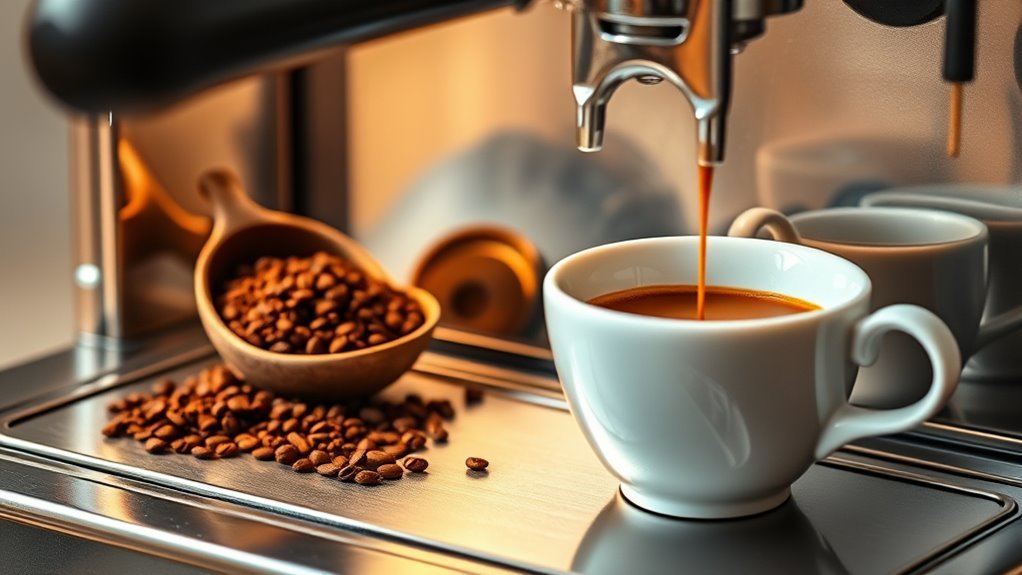Can You Use Coffee Grounds in an Espresso Machine
You shouldn’t use used coffee grounds in an espresso machine. Espresso machines require finely-ground fresh coffee to achieve peak flavor and quality. Used grounds lose their essential oils and flavors, resulting in a dull or bitter taste. Fresh grounds provide the complexity and rich aroma necessary for a satisfying espresso. For the best results, prioritize freshness and proper preparation of your coffee grounds. Discover more about the nuances of coffee grounds and brewing techniques ahead.
Understanding Espresso Machines and Their Requirements

Espresso machines are intricate devices designed to brew concentrated coffee by forcing hot water through finely-ground coffee under pressure. To choose the right machine, you should understand the various espresso machine types available—manual, semi-automatic, automatic, and super-automatic. Each type has unique features and specifications that cater to different brewing styles and preferences. For instance, manual machines give you complete control over extraction but require skill, while automatic machines simplify the process. When evaluating espresso machine specifications, consider factors like pressure (ideally 9 bars), boiler type, and temperature stability. These elements considerably affect the quality of your espresso. Understanding these requirements empowers you to make informed decisions, ensuring every cup of espresso meets your standards for freedom and flavor.
The Benefits of Using Fresh Coffee Grounds
Using fresh coffee grounds greatly enhances your espresso’s flavor profile, ensuring a richer and more complex taste. They also retain ideal freshness, which is essential for capturing the coffee’s natural oils and aromas. Additionally, fresh grounds improve extraction efficiency, allowing for a more balanced and satisfying brew.
Enhanced Flavor Profile
While many factors contribute to the quality of your espresso, the freshness of your coffee grounds greatly impacts the flavor profile. Using fresh coffee grounds can elevate your espresso experience through:
- Flavor Complexity: Freshness allows for the full spectrum of flavors to emerge, enhancing the overall taste.
- Aroma Enhancement: The natural oils in fresh grounds release more aromatic compounds, creating a richer scent.
- Balanced Acidity: Fresh grounds contribute to a well-rounded acidity, preventing any off-putting sourness.
- Creamy Texture: Freshly ground beans produce better crema, adding to the mouthfeel and richness of your espresso.
Embracing fresh coffee grounds not only satisfies your palate but also fuels a deeper appreciation for the art of espresso-making.
Optimal Freshness Retention
Freshness is key when it comes to maximizing the potential of your coffee grounds, especially for espresso. To achieve ideal freshness retention, consider how you store your coffee. Keep your grounds in an airtight container in a cool, dark place, away from moisture and heat. This ideal storage prevents oxidation and preserves essential oils that contribute to flavor. Freshness tips include buying whole beans and grinding just before use, as this preserves the aromatic compounds. Remember that coffee grounds can lose their flavor within days if not properly stored. By prioritizing freshness, you not only enhance your espresso experience but also guarantee that each cup delivers the robust, rich flavors you crave. Enjoy the freedom of crafting your perfect brew!
Improved Extraction Efficiency
The efficiency of extraction in espresso brewing largely hinges on the freshness of your coffee grounds. Fresh grounds enhance brewing efficiency by ensuring ideal flavor and aroma extraction, allowing you to enjoy a rich, vibrant cup. Here are some key benefits to take into account:
- Enhanced Flavor Profiles: Fresh grounds yield more complex flavors, making each sip enjoyable.
- Improved Aroma: Freshness contributes to an engaging aroma, elevating your overall coffee experience.
- Consistent Extraction Techniques: Fresh grounds promote uniformity in extraction, reducing bitterness or sourness.
- Maximized Caffeine Extraction: Freshness aids in extracting caffeine effectively, giving you that desired boost.
The Drawbacks of Using Used Coffee Grounds
Although it might seem eco-friendly and cost-effective to use used coffee grounds in an espresso machine, several drawbacks can undermine the quality of your brew. First, flavor degradation is a significant issue; once coffee grounds have been brewed, they lose essential oils and compounds that contribute to a rich taste. This leads to a flat or bitter cup, which isn’t what you’re aiming for. Additionally, using previously brewed grounds can raise sustainability concerns, as it may encourage practices that compromise the freshness of your coffee. The grind size and texture won’t be ideal for espresso, affecting extraction efficiency. Ultimately, while the idea may seem appealing, the potential downsides often outweigh the benefits of reusing coffee grounds in your espresso machine.
How to Properly Prepare Coffee Grounds
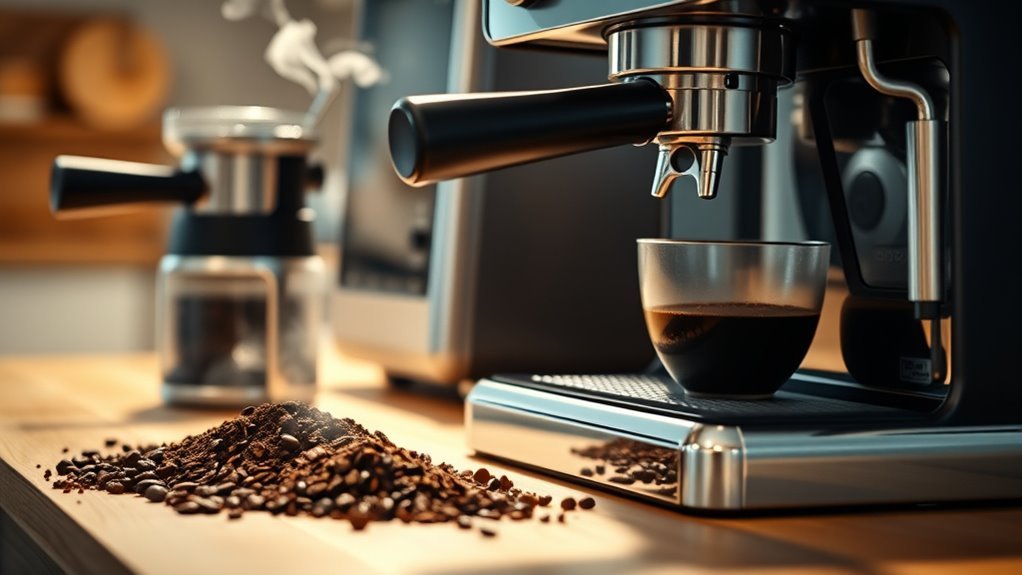
To achieve the best espresso, you need to focus on three key factors: grind size, freshness, and dosage. The grind size affects the extraction rate, while using fresh grounds guarantees peak flavor. Additionally, proper dosage and tamping create the right pressure for a balanced shot, making these elements essential for your espresso success.
Grind Size Importance
When brewing espresso, achieving the right grind size is essential for releasing the full flavor potential of your coffee. An inconsistent grind can lead to uneven extraction, affecting taste and quality. Here are four key aspects to take into account:
- Grind Consistency: Aim for a uniform texture; this guarantees even extraction during brewing.
- Brew Temperature: The grind size impacts how heat interacts with the coffee. Finer grinds retain heat better, enhancing flavor.
- Pressure: A properly adjusted grind allows ideal pressure during extraction, maximizing flavor.
- Taste Profile: Different grind sizes can highlight various tasting notes. Fine grinds often yield richer flavors, while coarser options might produce a milder experience.
Focus on these factors to elevate your espresso game!
Freshness of Grounds
Fresh coffee grounds play an essential role in the quality of your espresso, and using them at their peak freshness can greatly enhance your brewing experience. The benefits of fresh grounds are numerous, as they contribute to a richer flavor profile and aromatic complexity. To guarantee coffee freshness, focus on proper storage and grinding techniques.
| Fresh Ground Benefits | Importance |
|---|---|
| Enhanced Flavor | A more vibrant cup |
| Rich Aromatics | Pleasing scent |
| Better Crema | Improved texture |
| Consistent Extraction | Balanced brew |
| Increased Caffeine | More energy boost |
Dosage and Tamping
The quality of your espresso isn’t just determined by the freshness of the coffee grounds; dosage and tamping also play pivotal roles in achieving the perfect shot. To master these elements, consider the following:
- Measure precisely: Use a scale to guarantee dosage precision, typically between 18-20 grams for a double shot.
- Select your grind: A fine, consistent grind is essential for effective extraction.
- Employ proper tamping techniques: Apply even pressure, about 30 pounds, to create a level surface.
- Check for consistency: After tamping, tap the portafilter to settle the grounds evenly.
Impact on Flavor: Fresh vs. Used Grounds
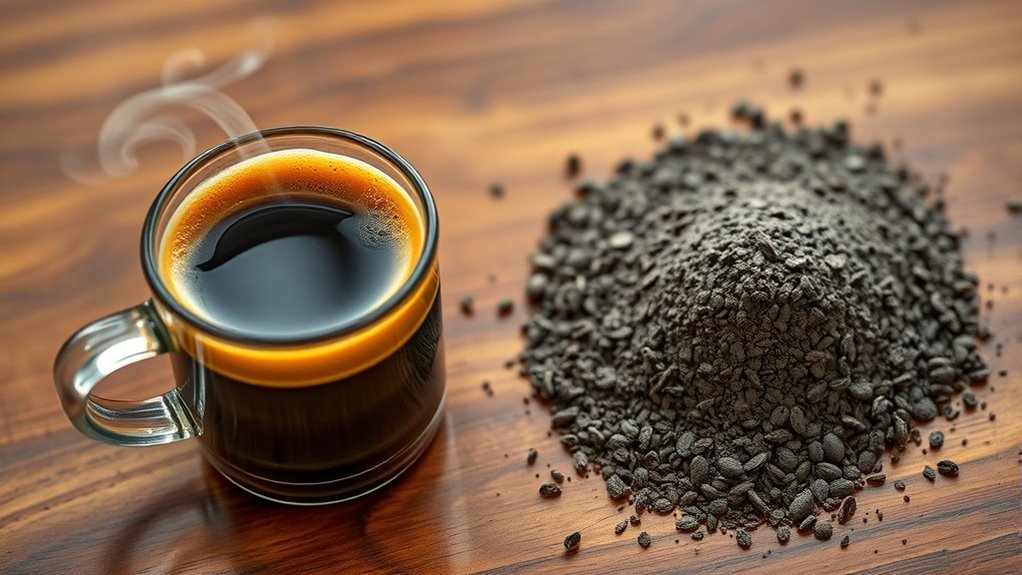
Flavor profiles in espresso are greatly influenced by the freshness of coffee grounds used during brewing. When you brew with fresh grounds, you reveal a spectrum of flavor nuances that enhance your espresso experience. In contrast, used grounds often lead to a muted taste, lacking the vibrancy of fresh coffee.
Here’s a quick taste comparison:
| Fresh Grounds | Used Grounds |
|---|---|
| Bright acidity | Dull, flat flavors |
| Rich aroma | Limited aroma |
| Complex flavors | Monotonous notes |
| Intense sweetness | Bitter aftertaste |
Brewing Techniques for Used Coffee Grounds
While fresh coffee grounds deliver a vibrant espresso, there are brewing techniques that can help you make the most of used grounds. To optimize your espresso experience, consider the following methods:
- Double Brewing: Use used grounds for a second brew, allowing the flavors to extract differently.
- Temperature Control: Experiment with water temperature; slightly cooler water can preserve some flavors in used grounds.
- Fine Grind: Grind the used grounds a bit finer to enhance extraction while avoiding bitterness.
- Shorter Brew Time: Reduce the brewing time to prevent over-extraction, which can lead to undesirable flavors.
Cleaning and Maintenance Considerations
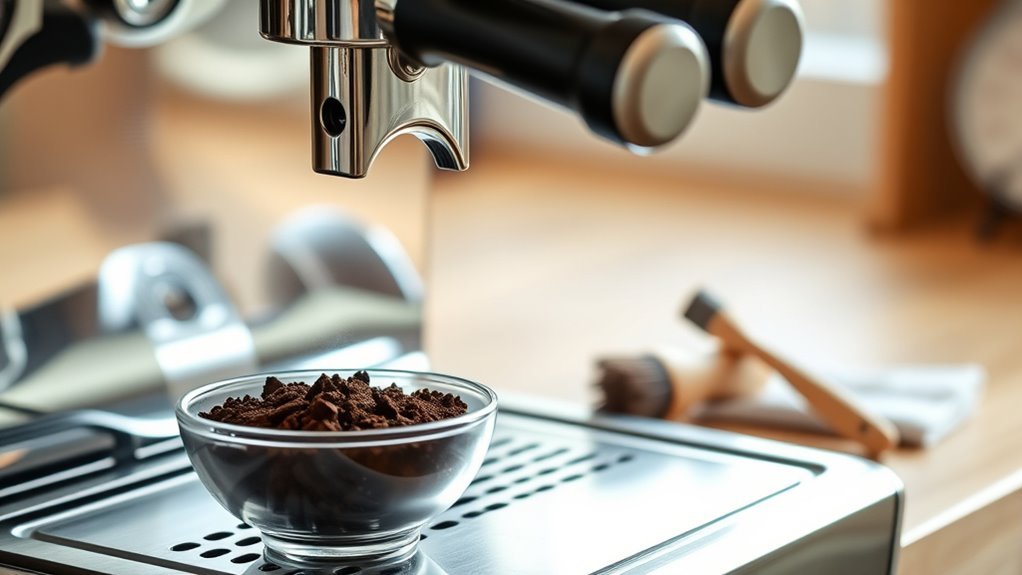
Cleaning and maintaining your espresso machine is essential, especially when using coffee grounds multiple times. Regular cleaning prevents residue buildup, which can affect the flavor of your brews. Start with daily cleaning tips: rinse the portafilter and brew basket after each use to remove oils and grounds. Incorporate a weekly maintenance routine by backflushing the machine with water and using a specialized cleaner to guarantee all internal components stay fresh. Don’t forget to descale monthly to eliminate mineral buildup. Pay attention to the water reservoir, too; empty it regularly to avoid stagnant water. By committing to these cleaning and maintenance routines, you’ll guarantee your espresso machine operates efficiently, giving you the freedom to enjoy delicious coffee every time.
Alternatives to Using Coffee Grounds in Espresso Machines
If you’re looking to diversify your espresso-making experience, there are several alternatives to traditional coffee grounds that can enhance your brews. Consider the following sustainable alternatives and flavor enhancing additives:
- Chicory Root – Offers a deep, earthy flavor and is caffeine-free.
- Dandelion Root – Adds a slightly bitter, nutty taste, perfect for a unique twist.
- Roasted Barley – This grain provides a rich, toasty flavor that mimics coffee.
- Maca Powder – A superfood that enhances energy levels and adds a malty sweetness.
These options not only broaden your flavor palette but also align with sustainable practices, allowing you to explore new dimensions in espresso without relying solely on traditional coffee grounds.
Expert Opinions on Using Coffee Grounds in Espresso Machines
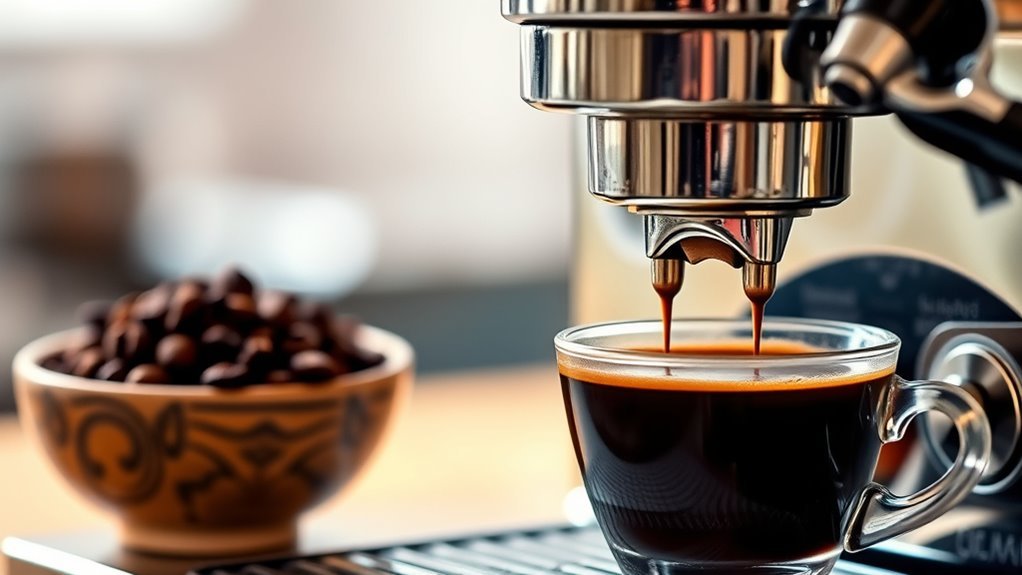
When considering the use of coffee grounds in espresso machines, many experts emphasize the importance of grind size and freshness. Using the right coffee ground types can greatly impact your brewing methods and the overall flavor profile of your espresso.
| Coffee Ground Type | Recommended Brewing Method |
|---|---|
| Coarse | French Press |
| Medium | Pour Over |
| Fine | Espresso |
Experts suggest that pre-ground coffee may lack the essential oils and flavors that fresh grounds provide. Additionally, if the grind size is too coarse or too fine, it can lead to under-extraction or over-extraction, resulting in undesirable taste. Aiming for the perfect espresso involves balancing these variables to achieve that rich, bold flavor you desire.
Frequently Asked Questions
Can I Use Flavored Coffee Grounds in an Espresso Machine?
Imagine waking up to the rich aroma of hazelnut coffee wafting through your kitchen. You might wonder if you can use flavored coffee grounds in your espresso machine. While it’s possible, be cautious. Flavored coffee can alter the espresso taste, sometimes overpowering the natural flavors. If you choose to experiment, make certain the grounds are finely ground and not overly oily, as this could clog your machine and affect its performance. Enjoy your freedom to explore!
How Fine Should Coffee Grounds Be for Espresso?
When you’re brewing espresso, the grind size is essential for ideal flavor. Ideally, you should aim for a fine grind, similar to table salt. This allows for proper extraction time, typically around 25-30 seconds, ensuring the water interacts sufficiently with the coffee grounds. If the grind’s too coarse, your espresso may taste weak or under-extracted, while overly fine grounds can lead to bitterness. Finding that perfect balance is key to enjoying a rich, flavorful shot.
Does Using Coffee Grounds Affect Espresso Machine Warranty?
Using coffee grounds in your espresso machine can have warranty implications. Many manufacturers specify the type of grounds to maintain peak performance. If you use grounds that don’t meet these standards, you risk voiding your warranty. Additionally, maintenance considerations come into play, as improperly ground coffee can lead to clogs or damage. It’s crucial to check your machine’s guidelines to confirm you’re preserving your warranty while enjoying your coffee freedom.
Can I Mix Fresh and Used Coffee Grounds?
You can mix fresh and used coffee grounds, but it’s vital to take into account the impact on flavor and extraction. Fresh grounds provide vibrant flavors and aromas, while used grounds may dilute these qualities. Combining them might result in a unique taste, but you’ll need to experiment to find the right balance. Remember, the freshness of your coffee plays a significant role in the final brew, so keep that in mind when mixing.
Are There Specific Coffee Grounds to Avoid in Espresso Machines?
When it comes to espresso, not all coffee types are created equal! You wouldn’t want to ruin your perfect brew with coarse or overly oily grounds. Stick to finely ground coffee, ideally Arabica, for that smooth extraction. Avoid robusta grounds unless you’re seeking a punchy bitterness. Remember, grind size matters; too coarse won’t extract properly, and too fine can clog your machine. Choose wisely to reveal your espresso’s full potential!
